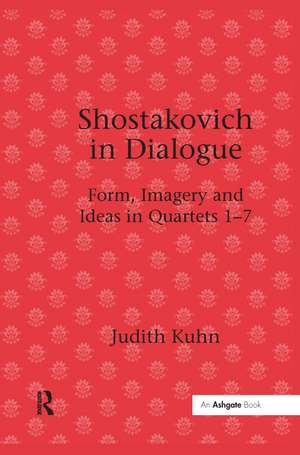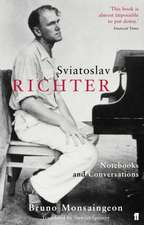Shostakovich in Dialogue: Form, Imagery and Ideas in Quartets 1-7
Autor Judith Kuhnen Limba Engleză Paperback – 11 noi 2016
| Toate formatele și edițiile | Preț | Express |
|---|---|---|
| Paperback (1) | 489.26 lei 6-8 săpt. | |
| Taylor & Francis – 11 noi 2016 | 489.26 lei 6-8 săpt. | |
| Hardback (1) | 1118.65 lei 6-8 săpt. | |
| Taylor & Francis – 28 feb 2010 | 1118.65 lei 6-8 săpt. |
Preț: 489.26 lei
Nou
Puncte Express: 734
Preț estimativ în valută:
93.65€ • 101.76$ • 78.72£
93.65€ • 101.76$ • 78.72£
Carte tipărită la comandă
Livrare economică 21 aprilie-05 mai
Preluare comenzi: 021 569.72.76
Specificații
ISBN-13: 9781138257337
ISBN-10: 1138257338
Pagini: 314
Dimensiuni: 156 x 234 x 17 mm
Greutate: 0.45 kg
Ediția:1
Editura: Taylor & Francis
Colecția Routledge
Locul publicării:Oxford, United Kingdom
ISBN-10: 1138257338
Pagini: 314
Dimensiuni: 156 x 234 x 17 mm
Greutate: 0.45 kg
Ediția:1
Editura: Taylor & Francis
Colecția Routledge
Locul publicării:Oxford, United Kingdom
Cuprins
Contents: Introduction; Quartet No. 1 in C, Op. 49 (1938); Quartet No. 2 in A, op. 68 (1944); Quartet No. 3 in F, Op. 73 (1946); Quartet No. 4 in D, Op. 83 (1949); Quartet No. 5 in B flat, Op. 92 (1952); Quartet No. 6 In G, Op. 101 (1956); Quartet No. 7 in F# minor, Op. 108 (1960); Epilogue: Shostakovich in dialogue; Select bibliography; Index.
Notă biografică
Dr Judith Kuhn is a recovering lawyer who received her PhD in musicology from the University of Manchester, UK, in 2005. She currently teaches musicology at the University of Wisconsin-Milwaukee in the USA.
Recenzii
'It took decades for Shostakovich's string quartets to assume their rightful place in the Western concert repertoire, and it has taken even longer for commentators to catch up with their richness of meaning and their subtlety of construction. Judith Kuhn guides the reader gently but authoritatively through the first seven of the cycle of 15 works, balancing astute musical observation with rich detail on context, reception and theory, and offering level-headedness without stuffiness, information without condescension, description without tautology, interpretation without coercion. For performers, listeners and scholars with any interest in these masterpieces, her study is now the obvious first source to consult.' David Fanning, University of Manchester, UK 'Kuhn's meticulous survey of Shostakovich's quartets draws upon personal, analytical and historical resources to forge a valuable scholarly resource. The field of Shostakovich studies is all the richer for it.' Pauline Fairclough, University of Bristol, UK 'Kuhn's sensitive musical ear and her gift for narrative writing create a series of exciting and interesting descriptions that shed a bright new light on the works discussed. ... Despite her theoretical references, Kuhn's writing is not speculative. She supplies the reader with a clear and perceptive discussion of complex scenarios, where political and aesthetic ideologies clash and contradict yet also converge. Her careful and detailed analysis is accompanied by tables and many musical examples, and her fluent narration, sometimes even touching on the poetic, makes reading the book not only an exciting voyage into new insights, but also a sheer literary pleasure.' Slavic Review 'It's very hard for a musicologist to present a technical argument that is both comprehensible and convincing to lay readers, but Kuhn has done a first-rate job.' London Review of Books 'The book [...] provides impressively comprehensive analysis of these extremely complex works, show
Descriere
Much of the controversy about Shostakovich's music has been related to questions of meaning. In this book, Kuhn examines each quartet in turn, looking first at its historical and biographical context, with special attention to the cultural questions being discussed at the time of its writing. She then surveys the work's reception history, and follows with a critical discussion of the quartet's architectural and harmonic features. Using the new tools of Sonata Theory, Kuhn provides a fresh analytical approach to Shostakovich's music, giving valuable and detailed insights into the quartets, showing how the composer's mastery of form has enabled these works to be heard as active participants in the Soviet and Western cultural discourses of their time, while remaining compelling and relevant to twenty-first century listeners.













